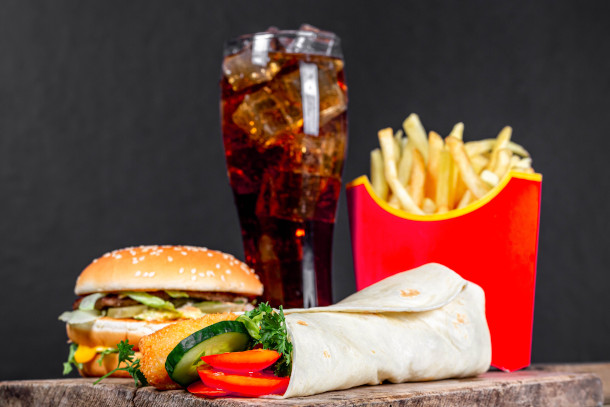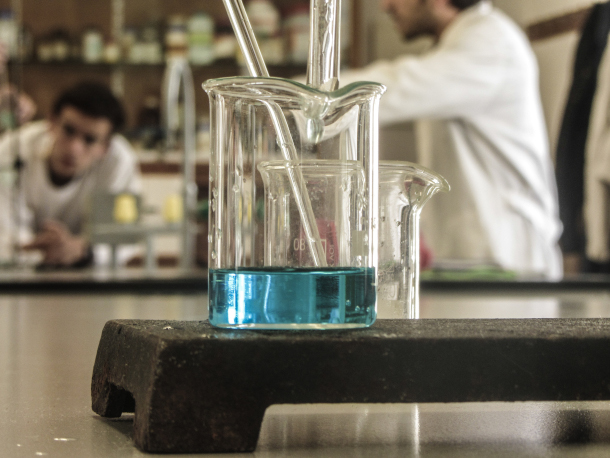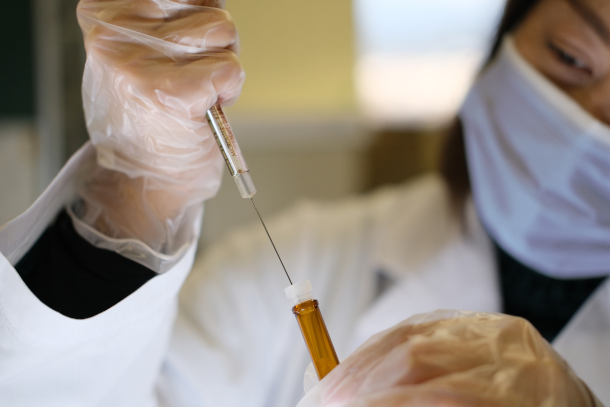Fast Food with a Side of Phthalates
Air Date: Week of August 26, 2022

The study analyzed hamburgers, fries, chicken nuggets, chicken burritos, and cheese pizza and found detectable levels of plasticizers and concerning orthophthalates. (Photo: Marco Verch, Flickr, CC BY 2.0)
Fast food could be even more unhealthy than we knew, as a study that sampled fast food items from six major chains found toxic chemicals linked to serious health problems and even early death. Researchers found that at least 70 percent of the fast-food items tested contained phthalates, which are used to soften plastics. Dr. Ami Zota, associate professor at George Washington University’s Milken School of Public Health and co-author of the study, joins Host Steve Curwood to discuss.
Transcript
Note: This segment starts at 15:18 in the above podcast file.
BASCOMB: It’s Living on Earth, I’m Bobby Bascomb
CURWOOD: And I’m Steve Curwood. Cheeseburgers, chicken nuggets and burritos are among the menu items sold by popular fast-food restaurants and more often than not they contain chemicals linked to serious health problems and even early death. This news comes from a preliminary study conducted by public health researchers at George Washington University. They found that at least 70 percent of the fast-food items tested in samples from six fast food chains contained toxic chemicals called phthalates, which are used to soften plastics. Some of the plasticizers that made their way into the food samples appeared to come from plastic gloves used to handle the food. For this study published in the Journal of Exposure Science and Environmental Epidemiology, the GWU team looked at three types of fast food: burgers, pizza, and Tex Mex. They found phthalates everywhere they looked but found higher levels
in meat from burgers and chicken burritos. For more I’m joined now by Dr. Ami Zota, co-author of the report. Dr. Zota, welcome back to Living on Earth!
ZOTA: Thank you for having me.
CURWOOD: So, why study phthalates in fast foods?
ZOTA: That's a great question. So, phthalates are a class of plasticizers. So, they're a class of synthetic chemicals that are ubiquitous in our environment. They have a lot of demonstrated health effects that we're concerned about, including effects on the reproductive system like fertility, male reproductive development, like sperm concentrations, and sperm function, and even neurodevelopmental effects in children. And so, we want to reduce exposures because we're concerned about the public health impacts. And it ends up that diet, and our food is a really important pathway.
CURWOOD: So, what kinds of fast foods did you study? Which kinds had the most amounts of phthalates in them?
ZOTA: We picked burger restaurants, pizza restaurants, and Tex Mex. We used market share data to go after, you know, the ones that were the most people eat. And interestingly, you know, there weren't huge variations across chains, which to me suggests that this is an industry wide issue. We did find differences by food type. So, for example, generally, foods containing meats such as cheeseburgers and chicken burritos had higher levels of chemicals than those without meat like cheese pizza.
CURWOOD: Which fast food chains are we talking about here?
ZOTA: That's a question that everyone wants to know. So, those are available in the paper. And we tested McDonald's and Burger King, Pizza Hut and Domino's and Taco Bell and Chipotle.

In this study researchers sampled 64 fast food items from different restaurants as well as three pairs of unused handling gloves and looked for 11 kinds of phthalates. (Photo: DisconnecTomas, Flickr, CC BY-ND 2.0)
CURWOOD: Now, not all chemicals that can make plastic soft are the same, and some, but not all, have been shown to be harmful to human health, as you say. So, what exactly, which chemicals did you find here, exactly?
ZOTA: These phthalates are, you know, several years ago, they were the dominant plasticizers used across the world. As I mentioned, they've been extremely well studied in human and animal studies. CPSC under the direction of Congress, I think about 10 years ago, passed a law restricting the use of certain phthalates like DEHP and dibutyl phthalate from children's toys. So, and those certain ortho-phthalates are also restricted by the European Union. So, there has been pressure on the private sector to begin to look for alternatives, and so we refer to these as non-phthalate plasticizers. They're still industrial chemicals, but they haven't been as well studied. You know, they may be less potent than DEHP, yet they may still contribute to negative health outcomes. And so one of the novel parts of our study, we found this rather newer plasticizer, DEHT, in fairly high concentrations, and we found it in the food, and we found it in the food handling gloves that we tested. And there's virtually no data, no toxicology data, no epidemiologic data on DEHT, currently in the peer reviewed literature, and so you know, once again, we're doing a big experiment on ourselves, where we're allowing our population to be exposed to this chemical before we really understand, you know, whether it's safe.
CURWOOD: Of the fast food you studied, how many contained the phthalates that are known to be health hazards to humans, compared to the ones which have yet to be tested?
ZOTA: We looked for 11 chemicals, we found 10 of them. So, we found virtually all of the phthalates that we were looking for in these fast food meals. The two that were most commonly detected were dibutyl phthalate and di-2 ethylhexyl phthalate or DEHP which is a particularly notorious agent. So dibutyl phthalate was detected in 81% of foods, and DEHP was detected in 70% of foods.
CURWOOD: And those chemicals are chemicals of the Consumer Product Safety Commission says should not be in children's toys at this point?
ZOTA: That is absolutely correct. Right. So, they find it concerning for them to be in children's toys, yet they are currently allowed to be used as food additives in the US as regulated by, as decided by the US FDA,
CURWOOD: Bobby Bascomb in our shop notes that in a Happy Meal for a child, it would not be okay to have phthalates in the toy, but yet it's okay to be in the burger, your thoughts?
ZOTA: I couldn't have said it better. I really couldn't have. So, hopefully, our study will help to shine a light on that and drive change so that you know when we're eating our burger, we don't have to eat plasticizers.
CURWOOD: And for the record of the plasticizers that have yet to have thorough human health reviews, what percentage of food that you tested had those?
ZOTA: Right, so, we looked at three alternate or replacement plasticizers and the one that was most ubiquitous was this DEHT. So it's a terephthalate, not an ortho-pthalate. And that was detected in 86% of the of foods. And it was also the one that was detected in all of the food handling gloves that we sampled, which we also obtained from the same restaurants where we collected the food.
CURWOOD: Are these chemicals? Are they attracted to fat? You scientists would call them lipophilic.
ZOTA: They are. That's right. But they are lipophilic, and they do bioaccumulate but not necessarily in the same way in your body. So, they're non-persistent in the body, but that is correct. So, they are more likely to be found in meats, dairies and oils. That's correct.

Plastics that make their way into food can come from gloves, industrial tubing, food conveyor belts and wrap packaging commonly used in fast food. (Photo: Japanese Expert, Flickr, CC BY 2.0)
CURWOOD: Tell me more exactly what you looked at, And I noticed you mentioned that food handling gloves were considered for the second phase of your study.
ZOTA: You know, we're interested in sources that wasn't the main objective of our study. But you know, ultimately, if we're trying to intervene, it's important to understand sources. And so several other studies had pointed out that these food handling gloves, which are often made of you know PVC plastic have high amounts of plasticizers, and when the gloves touch the food that plasticizer chemicals can actually migrate out of the gloves into the food, especially if that food is hot. And generally, we did find a pattern between the level of chemicals in the food in those restaurants and and what was in the gloves. But obviously, this is not a definitive analysis.
CURWOOD: What are the public health and regulatory implications of your work? Right now I don't see a label if I go to a fast food restaurant that says may contain phthalates.
ZOTA: Right, so currently, the whole class of ortho-phthalates that we are calling phthalates, as well as these replacement plasticizers, they're allowed to be used in as food additives, according to the FDA, so they're allowed to be in our gloves in our packaging, you know, in other types of plastics, like our tubing and conveyor belts, and there are no regulatory thresholds in terms of how much phthalates can be in your food. And so that would go under FDA authority, you know, allowing phthalates to be, you know, an allowable food additive. And so that's something that they're currently deciding on or considering at the moment.
CURWOOD: If I understand it correctly, it's pretty much impossible for an ordinary consumer to test food to see if it has phthalates contaminating it. So what should consumers do? What's the takeaway for consumers of fast food based on this preliminary study of yours?
ZOTA: That's right. A point you made is that while individual choice is important, we need policy solutions. I think one takeaway is that, you know, if you're eating out a lot, you are going to be increasing your exposure to these chemicals. And maybe you're fine with that, but you know, if you have vulnerable people in your family, you may want to reconsider. If you are going to eat, eat in moderation, and consider reducing your intake of meat because there, you know, there were higher amounts of these chemicals in meat.
CURWOOD: Dr. Amit Zota is a Professor of Environmental and Occupational Health at George Washington University. Thanks so much for your time today.
ZOTA: Thank you.
CURWOOD: We reached out to each of the fast-food chains cited in the study but did not get a response from any of them before our deadline. The Washington Post has quoted the FDA as saying, “Although the FDA has high safety standards, as new scientific information becomes available, we reevaluate our safety assessments.”
Links
Eurekalert | “Deaths To ‘Hormone Disruptor’ Chemical Costs Millions In US Productivity”
Living on Earth wants to hear from you!
Living on Earth
62 Calef Highway, Suite 212
Lee, NH 03861
Telephone: 617-287-4121
E-mail: comments@loe.org
Newsletter [Click here]
Donate to Living on Earth!
Living on Earth is an independent media program and relies entirely on contributions from listeners and institutions supporting public service. Please donate now to preserve an independent environmental voice.
NewsletterLiving on Earth offers a weekly delivery of the show's rundown to your mailbox. Sign up for our newsletter today!
 Sailors For The Sea: Be the change you want to sea.
Sailors For The Sea: Be the change you want to sea.
 The Grantham Foundation for the Protection of the Environment: Committed to protecting and improving the health of the global environment.
The Grantham Foundation for the Protection of the Environment: Committed to protecting and improving the health of the global environment.
 Contribute to Living on Earth and receive, as our gift to you, an archival print of one of Mark Seth Lender's extraordinary wildlife photographs. Follow the link to see Mark's current collection of photographs.
Contribute to Living on Earth and receive, as our gift to you, an archival print of one of Mark Seth Lender's extraordinary wildlife photographs. Follow the link to see Mark's current collection of photographs.
 Buy a signed copy of Mark Seth Lender's book Smeagull the Seagull & support Living on Earth
Buy a signed copy of Mark Seth Lender's book Smeagull the Seagull & support Living on Earth

